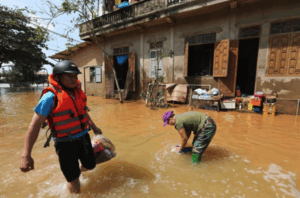HANOI – Relentless rains inundating central Vietnam since the weekend have killed at least 41 people and left nine missing, according to state media, prompting emergency declarations across multiple provinces and renewed concerns over the country’s vulnerability to intensifying climate shocks.
More than 52,000 homes have been flooded and over 500,000 households and businesses left without electricity as torrents of water swept through coastal and highland communities. Tens of thousands have been evacuated, officials said, as military and police units fanned out to erect temporary shelters and move residents to higher ground.
Rainfall in several districts has surpassed 1.5 meters over three days—exceeding the devastating 1993 benchmark in some areas—while landslides have damaged major roads and severed supply routes. The province of Lam Dong declared a state of emergency after part of the Mimosa Pass, a critical entryway to the tourist city of Da Lat, collapsed into a ravine, halting traffic. A bus narrowly avoided plunging into the chasm, according to Agence France-Presse.
Local outlets including Tuoi Tre and VnExpress published images of residents stranded on rooftops, entire neighborhoods swallowed by rising waters, and a suspension bridge torn from its anchors. Video shared on Vietnamese social media platforms shows floodwaters coursing through villages at speeds that residents said they had never witnessed before.
International meteorological agencies have noted a season of unusually severe storms in Vietnam. Typhoons Kalmaegi and Bualoi, which struck earlier this year, left widespread damage that has hampered farms and infrastructure still struggling to recover. Government estimates place total natural-disaster losses at $2 billion between January and October.
The latest deluge is dealing a sharp blow to Vietnam’s Central Highlands, the country’s premier coffee-growing region. In Dak Lak, Vietnam’s largest producer of robusta beans—widely used in instant coffee and global espresso blends—tens of thousands of homes were submerged and harvests delayed for weeks. Analysts warn that prolonged disruptions could tighten international coffee supplies at a time when global demand remains strong.
Authorities say the extreme rainfall may continue through Sunday. Climate specialists in Vietnam and abroad note that warming oceans and shifting atmospheric patterns have intensified storm behavior across Southeast Asia, increasing both the frequency and severity of typhoons.
As waters continue to rise, emergency teams are bracing for additional evacuations—and families across central Vietnam face a long road to recovery once the rains cease. (hb)
Photo: VNN

